[et_pb_section bb_built=”1″][et_pb_row][et_pb_column type=”4_4″][et_pb_text _builder_version=”3.0.101″ background_layout=”light” text_line_height=”1.4em”]
A recent intercession course taught by Professor Josh Smith of the University of Arkansas Department of English, “the History of the Book”, called on students to find a resource of their choosing in Special Collections and conduct a study of the book’s materiality. Amanda White, a graduate student who participated in the Intercession course, shares some of her findings in this blog post. She examined various aspects of Sharon Turner’s The History of the Anglo-Saxons: From the Earliest Period to the Norman Conquest, one of the many rare books that can be found in the Special Collections of the University Libraries.
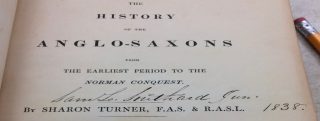
Special Collections houses an invaluable number of texts; everything from state archives, to medieval manuscripts, to rare books, represent just a few of the resources that are available to researchers. Professors, international scholars, and students are continuously invited to peruse the library’s holdings, be it for course related or personal research projects. At first glance, Sharon Turner’s book looks delicate and battered. The cover is quite worn, and the leather has sustained several scratches and dents, as well as some staining. The cover of the spine is battered, with much of the leather peeled off around the edges; although the gold tooling around the edges of the spine, front and back covers is still in good condition. The interior of the book shows damage where the pages meet the spine, probably owing to the book being read quite a lot; and there is a well-worn map of the British Isles, carefully folded, that lies along the interior of the front cover. When Turner’s book first came into my hands, my research became focused on two things: the marginalia found throughout the book, and its provenance.
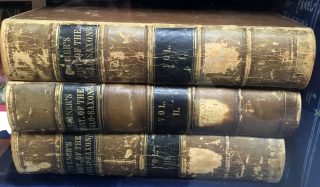
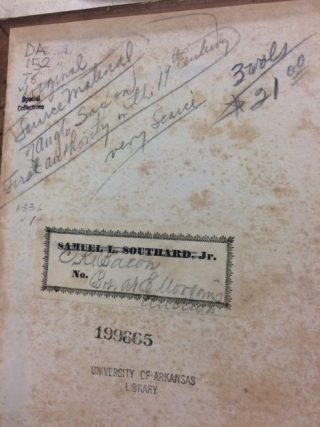
Marginalia, any piece of writing added into a book’s margins by its owner, is a common occurrence in many different texts, and can often be the very reason a book can be defined as “rare”. Turner’s book contained several pieces of marginalia throughout its pages. The first piece reads , “Original Source Material of Anglo Saxon…First Authority in the 19th Century…very scarce…3 vols…$21.00…1836 v 1”, and is accompanied by a sticker that marks it as a product for purchase at an auction house. The specific auction house in question, I cannot say; I have been unable to find the exact establishment that owned this text before it came into the University of Arkansas’s possession. The second piece of marginalia reads, “Sam. L. Southard jr. from his affectionate and only sister. 1838”. In addition to a series of dashes and brackets that were littered throughout the book’s contents, the final piece of marginalia was an index of sorts, penned into the final fly leaves by one of the book’s owners. This “index” marked off passages that were clearly important to the book’s owner, and correspond to the various dashes and brackets that are found throughout the book. It was at this stage in my research that I became interested in the book’s provenance.
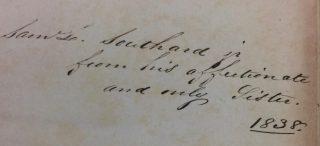
Provenance refers to the book’s production and ownership history that scholars are concerned with when they examine a book’s materiality. I began my search for this book’s provenance by researching the book’s original owner: a Mr. Samuel Lewis Southard Junior, who was given this book as a gift from his older sister Virginia. The original owner of Turner’s book belonged to the Southards, a politically influential family from New Jersey, circa the 1800s. Both Samuel L. Southard Jr., and his father, worked in law and served in various political positions.
Given the amount of marginalia found throughout Turner’s book, I found it strange that an American lawyer and politician such as him would be so interested in a long-winded and detailed history of the Anglo-Saxons, written and published by an Englishman. But further research revealed why a man of Samuel L. Southard’s background valued this particular book. As it turns out, Southard’s political affiliations with the Jeffersonian Whig Party account for why he became so interested in Anglo-Saxon history.
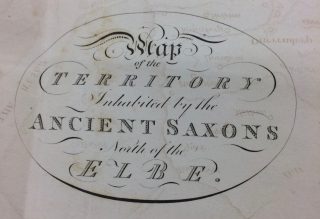
Turner’s book came into Southard’s possession in 1838, a time when the newly formed United States was still struggling to create a national identity, and justify their successful rebellion in the eyes of the rest of the world. Thomas Jefferson, prominent politician and one of the leading members of the Whig Party, became one of the leading scholars and supporters of a swiftly growing field of study in America: that of Old English and Anglo-Saxon origins. It became part of their political agenda to create a national identity that was rooted in an Anglo-Saxon heritage. Doing so not only affiliated the Americans with a legendary group of people who were known for their bravery and courage in the face of despotism, but it also put the British in a troubling position. They themselves, in the past, had made use of their Anglo-Saxon origins to excuse their own rebellion; and when the Jeffersonian Whigs made use of the same political tactic, the British were left with few options but to accept the American revolution with grace, albeit reluctantly.
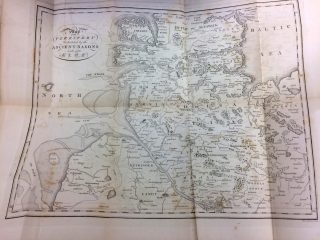
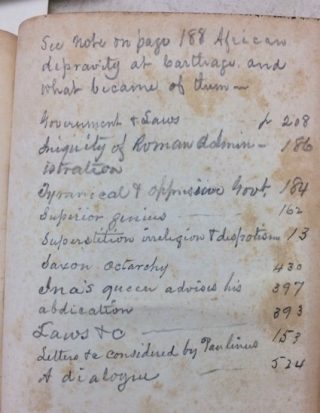
Given his affiliation with the Jeffersonian Whigs, it became very clear why Samuel L. Southard Jr. both owned Turner’s The History of the Anglo-Saxons and was highly interested in its contents. The amount of marginalia and the self-made “index” found in the book’s fly leaves also mark this book as a text for study, not just idle reading. Studying this book’s marginalia and provenance not only allowed me to discover the book’s original owner and the reason for his owning it, my research also gave me unique insight into the 19th century political landscape in America, a time where the nation was struggling for a national identity and an alibi to excuse their rebellion. Turner’s book is just one of many in Special Collections that students and other researchers will find useful for their own research. His The History of the Anglo-Saxons: From the Earliest Period to the Norman Conquest and two other volumes, also published in the early 1800s, are currently on display in the Special Collections Reading Room.
[/et_pb_text][/et_pb_column][/et_pb_row][/et_pb_section]
